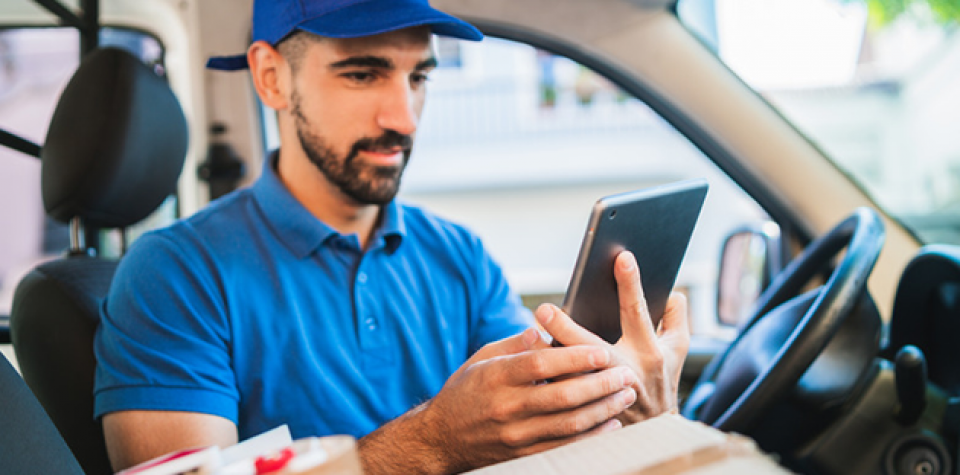Table of Contents:
- From Bricks to 5G Data
- The 1G bricks
- 2G brings the magic
- 3G evolves into 4G
- 5G and beyond
- How Can Logistics Software Integrate with My Mobile Device
- A vast network
- Get it done sharpish!
- Keep an eye on everything
- Safe and sound
- Go Mobile With TransVirtual
How mobile devices have empowered delivery drivers and made dispatching and monitoring much more efficient for logistics operators.
It’s hard to remember a time when mobile phones weren’t an indispensable part of our lives. The pace of change in mobile phone usage and network technology rollout has been phenomenal over the last twenty-five years.
The arrival in Australia of the first mobile “brick” phones marked the beginning of a transformative path that has revolutionized our lives and how we consume information.
Back then, the notion that we’d be managing our entire lives on a phone — from banking to video conferencing — seemed daft. But it has become a reality today.
In this article, we are going to look at the evolution of mobile phones in Australia and how mobile technology and Aussie ingenuity have intersected in the logistics industry to provide all sorts of benefits and breakthroughs for our hard-working delivery drivers and their dispatchers.
From Bricks to 5G Data.
Believe it or not, it’s nearly forty years since cell phones arrived in Australia! In that time we’ve gone from briefcase-sized devices that took a man and a boy to carry, all the way to the palm-sized computers we now all carry in our pockets.
The 1G bricks
Introduced in Australia in 1987, the 1G system offered voice-only communication and was symbolised by the much-parodied analogue “brick” phones favoured by yuppies and flash stockbroker types…who were the only people who could afford the extortionate call rates! But despite its limitations, 1G had a significant impact on society and set the stage for future advancements.
2G brings the magic
The next iteration of mobile phone technology was the 2G network, which launched in 1993. This brought digital technology to cell phone users and introduced services such as text messaging and SIM cards. The 2G service offered improved voice quality and increased network capacity, along with features such as caller ID and international roaming.
The CDMA (Code Division Multiple Access) networks, introduced in 1999, replaced the analogue 1G network in rural areas and provided better coverage over Australia’s vast inland. CDMA paved the way for the future 3G network but was only ever designed to be a short-term mobile strategy. It was eventually shut down in 2008.
3G evolves into 4G
The 3G network ushered in the era of the smartphones we know and love. Web browsing, app stores and access to information on the go became integral to people’s lives. Further advancements in cell technology brought about 4G which gave us mobile ultra-broadband internet access with faster speeds, lower latency and reduced congestion on the network.
Australia was one of the first countries to introduce LTE (Long Term Evolution) technology into its cell phone network and this expanded the capabilities of 4G, resulting in significantly improved speeds and an enhanced user experience.
5G and beyond
The 5G network began rolling out across Australia in 2022. 5G allows for data download speeds of up to 20Gbps and latency as low as 1 millisecond. Latency, by the way, is the time it takes for information to get from your phone to the internet and back. This is especially important when it comes to monitoring the speed and location of vehicles and so has major implications for Transport Management Systems and courier logistics software.
How Can Logistics Software Integrate with My Mobile Device?
In the fast-paced and rapidly-evolving world of logistics, integrating mobile devices with advanced logistics software has become a game-changer. By seamlessly combining the efficiency of mobile devices with cutting-edge software, logistics operators can unlock new levels of productivity and real-time visibility like never before.
A vast network
Picture this: a delivery driver (let’s call her Danielle) is cruising through the bustling streets of Melbourne, armed with a trusty mobile device in her hand. Gone are the days of scribbled notes and frantic calls to dispatchers. With her mobile device, Danielle now has a powerful arsenal of software solutions at her fingertips.
She can access real-time information about road and traffic conditions, update the delivery status of the freight she is carrying, capture electronic signatures from customers, and communicate effortlessly with the dispatchers back at the office. All in a matter of a few taps on the screen of her device. It’s like having a network of communication the size of the Barrier Reef in her pocket!
Get it done sharpish!
Time is money in the logistics world. People want their stuff right now (or earlier) and mobile devices are the virtual lightsabres in the logistics industry’s heroic pursuit of efficiency. Having a
Streamlined mobile workflows allow them to receive job updates instantly, optimise routes on the fly, and capture proof-of-delivery with a tap and a snap. They can also keep customers informed about the progress of their goods, ensuring a smooth and timely delivery experience.
Keep an eye on everything
The old adage that information is power has never been more true than it is today. And the constant flow of information made possible by mobile devices now offers unparalleled visibility between you and your staff out on the road.
TransVirtual‘s TMS software, for example, provides real-time tracking capabilities, allowing your drivers and your dispatchers to monitor deliveries every step of the way. And it doesn’t matter whether you are tracking a shipment from Adelaide to Darwin or ensuring on-time deliveries in the middle of Sydney during rush hour, mobile devices make it possible to keep everyone in the loop.
With a few taps of the screen — securely mounted in a hands-free cradle, of course — drivers and dispatchers can find locations with pinpoint accuracy, identify potential holdups and bottlenecks, and make proactive decisions based on real-time information, They can even do this while enjoying a cuppa at their favourite Melbourne café!
Safe and sound
Aussie logistics operators value the safety of their drivers and the security of the cargo they are carrying above all else. Mobile-based features like GPS tracking mean drivers can navigate unfamiliar territories with ease, avoiding potential hazards like a kangaroo dodging traffic on the road to Cunamulla!
Mobile devices also facilitate effective communication between drivers and dispatchers, so if an emergency situation or an unforeseen circumstance pops up, it can be dealt with rapidly. TransVirtual’s commitment to operator safety is built into our software, so you can brave the urban jungles with confidence.
Go Mobile With TransVirtual.
The logistics landscape has been transformed by mobile device technology. From the sun-kissed beaches of the Gold Coast to the sunburnt country of the Outback, Aussie delivery drivers and dispatchers can now run their operations efficiently, speedily and safely via their mobile devices.
So if you’re a logistics operator looking to supercharge your operation, get in touch and let us help your business experience the true power of mobile-driven logistics. You could, for example, call us up on your mobile!



